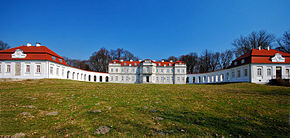Narol (town)
| Narol | ||
|---|---|---|

The palace of Count Łoś in Narol
|
||
|
||
| Coordinates: 50°21′1″N 23°19′38″E / 50.35028°N 23.32722°E | ||
| Country |
|
|
| Voivodeship | Subcarpathian | |
| County | Lubaczów | |
| Gmina | Narol | |
| Government | ||
| • Mayor | Stanisław Andrzej Woś | |
| Area | ||
| • Total | 12.4 km2 (4.8 sq mi) | |
| Population (2006) | ||
| • Total | 2,120 | |
| • Density | 170/km2 (440/sq mi) | |
| Time zone | CET (UTC+1) | |
| • Summer (DST) | CEST (UTC+2) | |
| Postal code | 37-610 | |
| Website | http://www.narol.pl/ | |
Narol [ˈnarɔl] (Ukrainian: Наріль, Naril’) is a town in Subcarpathian Voivodeship, in Lubaczów County, Poland. It had a population of 2,109 as of 2009[update]. Narol is situated in the northeast of Podkarpackie region, in an area called Narolszczyzna. The town of Narol regained the rank of 'city' in 1996.
The Bełżecki (Beuzhetski) family owned the area where the town of Narol is situated. At the end of the 15th century the lands changed ownership to the Marcinkowski Family. Narol was first called Florianów (Florianoov), from the name of Florian Łaszcz Nieledowski, who founded the town in 1596. Narol flourished because of trade with Gdańsk.
The army of the cossack Bohdan Khmelnytsky (c. 1595-1657) attacked the town on their way to Zamość. After a few days of siege, the town was overrun and burned to the ground by Khmelnytsky's forces. Twenty thousand people died during those fights, among them Florian Łaszcz, the owner of the town. A new town was built, somewhat west of the original location, "on a field" - hence "na roli". The new settlement assumed the new name Narol. In 1672 a great Hetman, John Sobieski, won a battle against the Tatars nearby. Later Sobieski became the Polish king.
In 1758 Felix Anthony Łoś (1737–1804) became the owner of Narol and a deputy and a general of the king's army. He opened a factory and a school in Narol. In 1776, he began constructing a palace in the form of a horseshoe (the coat of arms of Łoś family).
Near the palace there was an Italian style garden. Count Łoś was an avid collector of old writings, correspondence and manuscripts, and paintings of the Italian and Dutch schools. He accumulated one of the largest libraries in Poland at that time. He founded a drama and music school for children from more affluent families, which was located on premises of the palace. The palace was considered one of the most beautiful palaces in the whole country. After the death of Count Łoś, all of the collection was lost, with most of the library ending up in the hands of Count Jakub Potocki. In 1935 the books were donated to a public library in Warsaw.
...
Wikipedia


